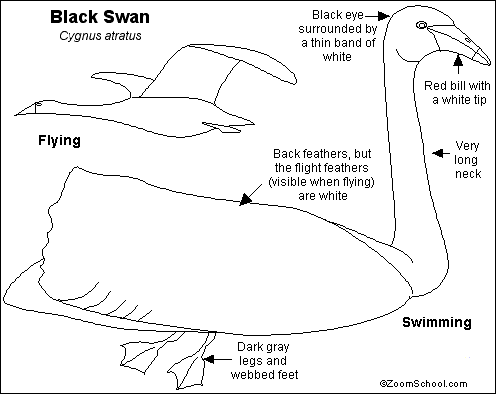The black swan (
Cygnus atratus) is an Australian native that has been introduced to other places, including New Zealand (where it is now considered a pest) and Sweden. The adult female is called a
pen, the adult male is called a
cob, and the baby is called a
cygnet. Black swans are very territorial. They make honking and hissing noises. Black swans fly in a V-shaped formation and can fly at speeds of up to 50 miles per hour (80 kph). The black swan is the emblem of the State of Western Australia.
Anatomy: Black swa

ns are long-necked black birds with a red beak tipped in white. The neck is longer than the body. Black swans have a wingspan of up to 6 feet (1.8 m) and are up to 4 feet (1.2 m) long. They weigh up to 13 pounds (6 kg). Males and females are similar in size.
Diet: The black swan eats mostly water plants and some grain. It reaches under the water with its long neck to get these plants, and it even eats the roots. Cygnets eat a lot of bugs and other small
invertebrates, since they feed mostly from the water's surface.
Eggs and Nests: These graceful waterfowl mate for life. Black Swans build large nests located near the water; they are lined with swan down (delicate feathers). Females lay 4-8 pale green eggs in each
clutch (a set of eggs laid at one time). Both parents care for the eggs and hatchlings.
No comments:
Post a Comment